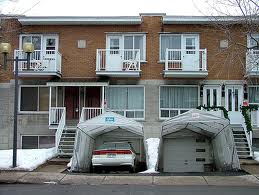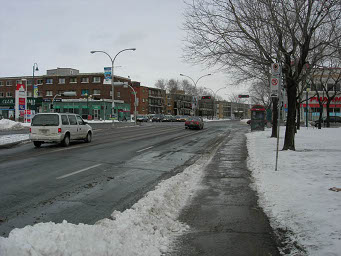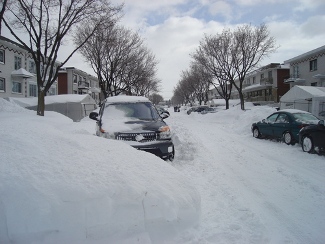

Montreal DistrictsSaint-Leonard DistrictLighter Period
The history of the Saint-Leonard district is divided into three periods. The first period, from 1886 to the mid 1950’s, is dominated by a rural life and a stable and homogeneous community. Mostly French and mostly farmers, the total number of the population didn’t change much. Cultivated grounds, a main street called Jarry, and a church describe Saint-Léonard in its early days.
During the second period, from 1955 to the mid 1970’s, the number of people and the number of construction sites exploded. It’s the most animated period in the history of Saint-Léonard district and borough. The territory grew so much and so rapidly that the municipality had to intervene in the urban control and planning. It all began when the members of a housing cooperative bought a land called “la terre Renaud” now delimited by Aimé Renaud, des Artisans, Alphonse Desjardins, Place des Fondateurs and other neighbouring streets. The members decided to build a vast domiciliary unit based on the organisational values of a cooperative. The cooperative and its domiciliary project enabled many workers with modest incomes to buy a property and to raise their family in what was then a suburb of the city of Montreal. During this great domiciliary commotion, two other major events happened in the Saint-Leonard district. The first event was the arrival of a large number of Italian immigrants that modified the social dynamic of the community. The influx enriched the human, social and cultural values of the “léonardois”. 
The second event was the development of an urban plan by the municipality. The plan modeled the territory and gave it the characteristics it now has. In the Saint-Leonard district the municipality analyses, plans and elaborates everything, or almost everything in advance. As a result, many services like sporting installations, cultural activities and community resources have been developed for the benefit and the satisfaction of the population. Postmodern Period The layout of the streets, the opening of the large boulevards, the parks - the Saint-Leonard district has many parks - the harmonization of the buildings, the delimitation of all the territorial zones, nothing is left to random. There are, however, no Metro stations in the Saint-Leonard district, but the STM Montreal bus line network is somewhat sufficient. Since its creation, Saint-Léonard resisted six attempts of annexation but, ultimately, in 2002, it became one of the Montreal boroughs. As the years went by, the borough built collective scholar, medical, economic, urban, cultural, sporting and recreational installations, and bought proper equipments.  From the end of the 1970’s to today, from the years that followed the domiciliary boom, the Saint-Leonard district reinforced its urban plan and improved the services offered to the population so it could meet the new social realities.
From the end of the 1970’s to today, from the years that followed the domiciliary boom, the Saint-Leonard district reinforced its urban plan and improved the services offered to the population so it could meet the new social realities.The general quality of this interesting life structure masks certain levels of poverty and the problems that usually accompany them. Since the beginning of the 1990’s, the face and the dynamics of the population have been modified by the addition of Haitian, Arab and Latin immigrants. New services had to be created and new Community Centres had to be opened. The population is getting older, a significant change in the territory. Many Golden Age Community Clubs have been created and, together, they reach a rather large number of elders living in the vicinity. Importance of Leisure Activities For many, the urban development of Saint-Léonard is a success, for the “léonardois”, it's simply an art of living. The fact that the Arena Martin Brodeur has been named after the celebrated goalkeeper Martin Brodeur of the NHL Hockey league is in line with the mentality that prevails. Martin was born in Saint-Leonard and his sporting exploits must continue to be a source of inspiration to the young people of today. Cave Site A cave in the heart of Montreal. Located in the Pie IX Park, the cave of Saint-Léonard offers a chance to go back in time and to dive into the mysterious atmosphere of a cave. The entry opens on a rectangular room and then the well is easily accessible by using the ladders installed on the walls. Fortunately for some, it is not necessary to go down to the last ladder to appreciate the atmosphere of the cave. The cave, also known as the “Trou de fée” or Fairy Hole is 35 meters long with an 8 meters slope. It has been built so it could accomodate the needs of speleologists of all ages. Thank you for visiting Saint-Leonard District. Saint-Leonard Borough Images Montreal Exit Saint-Leonard District
|


























































